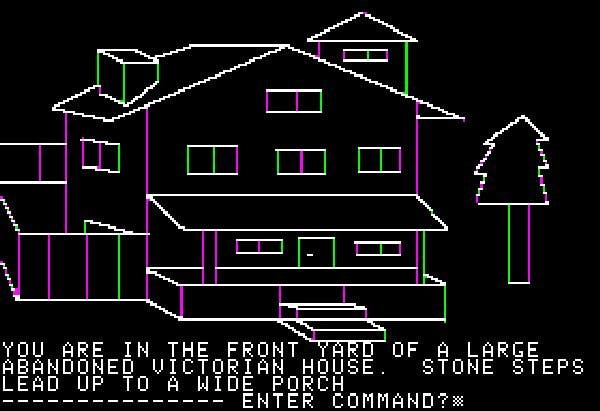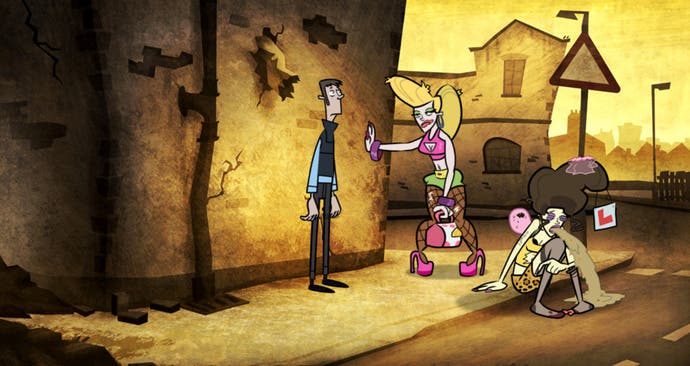Inside Adventure Games
The hitchhiker's guide to videogame adventuring.
Introduction
Once upon a time it was easy. Just 15 years ago most games slotted into their categories with librarian-pleasing snugness. Take the adventure game.
In 1985 they were text games with a focus on storytelling and puzzle solving. Five years later it was the same but with animated graphics and mouse clicks replacing the typing.
But defining the genre now is like hugging fog. The once firm borders of adventures have crumbled and their ideas have diffused out into the wider gaming ocean. Today the definition of an adventure game depends on what school of thought you embrace.

Dan Connors, head of adventure specialists Telltale Games, sees the genre as a broad church. His definition is inclusive not exclusive. It includes Heavy Rain and Uncharted as well as his company's more traditional efforts such as the Back to the Future adventures.
"In the late '80s and early '90s it was very clear cut," he says. "Now you could attribute the dialogue trees in Mass Effect to adventure games. A lot of the scripted storytelling in Valve's games comes from adventure games. I think adventure games went out and permeated every single genre because they've always remained the best way to interact with characters in a world and to interact with an environment."
Others view adventures in more exclusive terms. "Stories in games need to mould themselves around what gameplay a game is trying to deliver," says Charles Cecil, founder of Broken Sword developer Revolution Software. "Uncharted is absolutely not an adventure game as I would define it, same with Heavy Rain. Both require considerable expertise with a joypad and an adventure is a cerebral experience rather than one requiring manual dexterity."
A lack of violence or death is also a common trait of adventures, he adds. But even then Cecil's definition has grey areas thanks to the likes of L.A. Noire, which lets players skip the action and focus on its adventure-inspired detective work.
A Brief History
While the exact definition may be debatable, the origin of the adventure game isn't. The first adventure is the aptly named Adventure, a 1976 text game created by Will Crowther on his workplace's PDP-10 mainframe computer. It let players explore a world described in text by inputting verb-noun commands such as 'go north' or 'get torch'. As well as exploring there were puzzles to solve and monsters to encounter.
Within a few months a Stanford University student called Don Woods had rejigged the game, adding more puzzles, locations and fantasy elements. Woods' version became a sensation in the mainframe-computing scene of the late 1970s. Other computer users began creating their own adventures and it went on to inspire MUD, the first MMO - but that's another story.
By the time the first mass-produced home computers began rolling off the production lines adventures were an obvious choice for making the leap out of the labs and into our homes. In 1978 the first commercial adventure game - Adventureland for the TRS-80 - reached the shops. Its success established the genre as a mainstay of computer gaming and its creator Scott Adams formed one of the world's earliest game publishers Adventure International to feed the growing demand for adventure games.

Adams wasn't alone for long. The following year the MIT students who created the Adventure-inspired Zork! formed Infocom to bring their adventure to home computer users. Around the same time in California the husband and wife team of Ken and Roberta Williams set up On-Line Systems (later renamed Sierra On-Line) to publish Mystery House - the first adventure to include still pictures of its locations in addition to the usual text. Soon text adventures went global, spawning especially vibrant adventure game scenes in France and Japan - although it was the work of Infocom and Sierra that dominated the text adventure era of the early to mid 1980s.
But as the '80s progressed the adventure game began to evolve. In 1984 Sierra came out with its fairy tale adventure King's Quest, which introduced animated visuals to the genre, and the following year Illinois developer ICOM Simulations released Déjà Vu: A Nightmare Comes True, which replaced text input with a Apple Mac-inspired point and click approach. By 1987 these two ideas - point and click interaction coupled with animated visuals - came together in Lucasfilm's Maniac Mansion. The text adventure had become the graphic adventure.
Lucasfilm's games outlet eventually became LucasArts, and it dominated the point-and-click era that followed with hits such as The Secret of Monkey Island (and at this time the adventure had mutated into a new genre - the visual novel - in Japan). In keeping with its roots in the movie business, LucasArts shifted adventure games away from Infocom's interactive novels to a more interactive movie with an approach drawing on the audio-visual and scriptwriting know-how of filmmakers.

By the mid-'90s adventuring's shift towards interactive movies reached its apex as the extra storage delivered by CD-ROMs allowed developers to add film footage, recorded audio and more detailed images to their creations. But for every CD success such as Myst or The Beast Within: A Gabriel Knight Mystery there were dozens of dismal games clogging the shelves such as Psychic Detective.
"They were an unfortunate blot of the history of adventures," says Cecil. "They came about because the bosses of publishers went to live in California because they thought it was cool to be near the film studios. Thankfully gamers just didn't buy them and it collapsed."
The adoption of 3D graphics and the success of the PlayStation blew the interactive movie dream apart. Players became more interested in the thrill of action than the slow, cerebral offerings of adventures. By 2000 the adventure game had become a niche genre, clinging on in places such as Germany but banished from the gaming mainstream. Deprived of an audience, adventure developers played it safe producing budget replicas of what was popular before the PlayStation.
It could have ended there for the adventure game, but in mid-2000s the tide started to shift. Telltale found success resurrecting LucasArts brands and selling them online as episodes rather than complete games. Then Nintendo's DS and Wii brought adventure games to a wider audience through games such as Hotel Dusk: Room 215 and most famously the puzzle adventuring of Professor Layton. Finally the success of the iPhone and other touchscreen smartphones created a gaming platform that had not just a mass audience but controls that were perfect for adventure games.
State of Play
Today adventures do sell in reasonable numbers and their number is spreading (there are even a few available on the Kindle). Cecil says the iPhone remake of Broken Sword sold three million copies, and Telltale is starting to release their games in stores with anticipated sales of 400,000.
Yet adventures often seem overshadowed by their past, partly because the point and click approach used in the LucasArts days is still standard. "It says something about how much love people have for the LucasArts style of gameplay that it's even talked about 21 years later as a one-to-one comparison," says Connors. "People still cling to this idea of what an adventure was in 1990."
But the way adventures function isn't as important as it might be for a first-person shooter says Dean Burke, creative director of the Hector games at Northern Irish developer Straandlooper. "The mechanics are rooted in the LucasArts games," he says. "But I feel that the reason people like adventure games is the characters in the stories. Adventures still have their flaws and could be improved, but the fundamentals will never change really. As with any form of entertainment it's about telling a good story."

While the core is unchanged, today's adventures place more emphasis on accessibility. "In the mid-90s adventure gamers liked the fact that they were getting frustrated so contrived puzzles sort of worked," says Cecil. "Now people want to play at their own pace."
As a result the puzzles are now more logical than the cryptic conundrums of old and adventures often include a hint option. The iOS version of Broken Sword, for example, has a hint option that offers a vague clue before, after several taps, the solution is revealed. "I was initially worried that people might find that it encouraged them to bypass the puzzles but it didn't," says Cecil.
More should be done though, says Jakub Dvorský of Amanita Design, the Czech developer behind 2009's robot adventure Machinarium. "Nowadays adventure games are more streamlined and accessible but they should try to be even more experimental," he says. "Any theme can be used for an adventure game and the developers should use their own new and distinctive approach to every aspect of game creation from plot and game design to graphic style, animation, music and sound."
The good news is that adventure developers now seem keen to experiment with new approaches. "The touchscreen is an extraordinarily good way of controlling an adventure because adventure games are very tactile in that you want to explore the environment," says Cecil adding that using first-person viewpoints, as well as the traditional third-person views, is something he is looking at.
Telltale, meanwhile, has tried to step away from the pace of traditional adventures with its latest game Jurassic Park. "We wanted it so that you come into the world and it makes you react and pulls you through it," says Connors. "We moved away from the 'I'm going to go through the world and interact at my own pace' and made it something where you need to react to the situation in front of you because it's a dangerous place. You know, we couldn't have it where you're trying to use a rubber chicken with a pulley in the middle on a dinosaur."
Reading List
Ready for an adventure? Then check these out...
A Mind Forever Voyaging (Apple II)
When it comes to text adventures almost any Infocom game is worth a go, but this clever critique of Reaganomics is still one of gaming's most effective pieces of political commentary. Manual's a must though.
The Secret of Monkey Island (iOS)
Like Infocom, most LucasArts adventures deliver the goods but none are as iconic as this comic tale of incompetent pirates and rubber chickens.
Broken Sword: Director's Cut (iOS, Wii, DS)
Move over Dan Brown and make way for this fine remake of the original Knights Templar conspiracy theory adventure.

Hotel Dusk: Room 215 (DS)
Japanese developer Cing's film noir mystery impresses not just with its pencil-sketch visuals but also with its top-notch dialogue.
Back to the Future: The Game (PC, Mac, iOS, PSN)
Great Scott! Telltale reunites Marty and Doc Brown with that iconic DeLorean for some more time-travelling adventures.
Hector: Badge of Carnage! Episode 1 (iOS, PC, Mac)
A Bottom and Viz inspired detective adventure packed with caustic un-PC humour. The banter with the hostage taker is worth the price alone.
The Book of Unwritten Tales (PC)
King Art's amusing spoof of the fantasy clichés proves that Germans do have a sense of humour and that the LucasArts formula still holds up today.
To the Moon (PC)
It might look like a Japanese role-playing game from the days of the Super Nintendo but this adventure about a dying man's final wish is a real tearjerker.








.png?width=291&height=164&fit=crop&quality=80&format=jpg&auto=webp)
